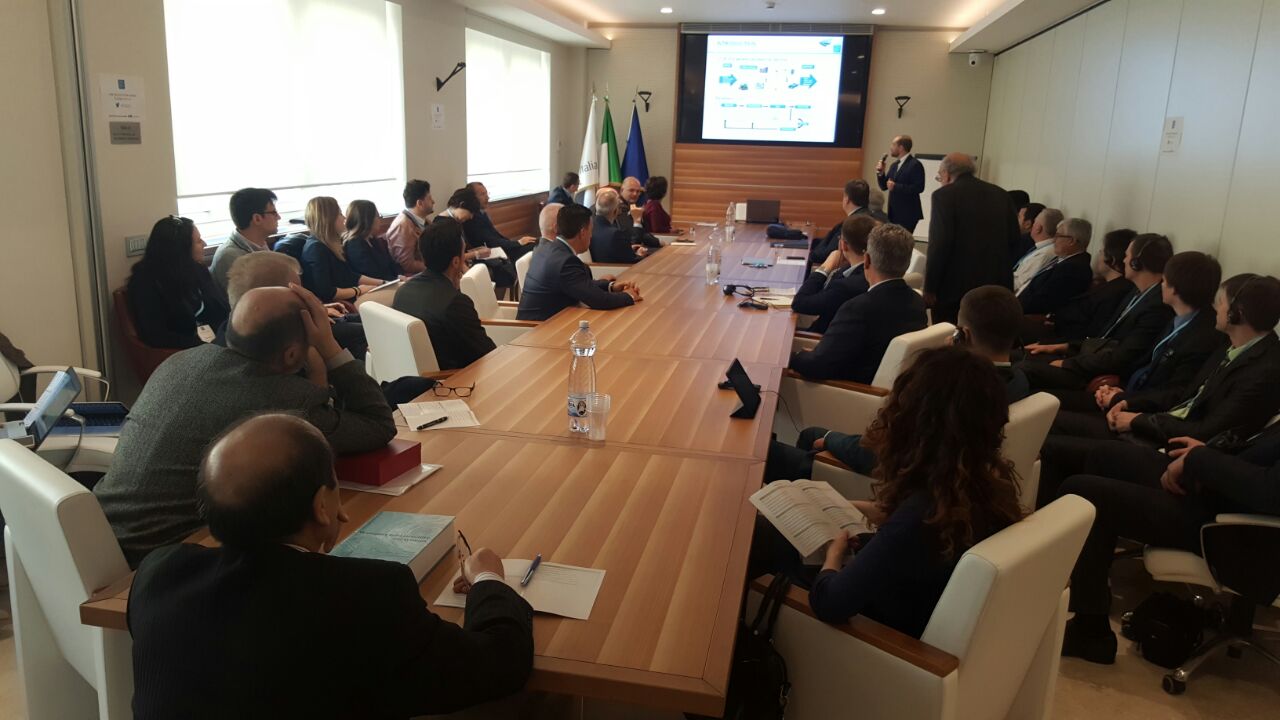TIS 2017
Session 16 – Road Performance Management

Ugo Dibennardo, director of the maintenance area of the Italian Agency of Road (ANAS) chaired the 16th session of the TIS Congress, presenting innovative experiences and methods applied to the Road Asset Management and developed in Italy and in other countries. The session also focused the aspects of a more sustainable approach to road maintenance with the use of advanced materials.
Eleonora Cesolini, Stefano Oddone and Sonia Gregori – Anas Quality Evaluation Management System / The ANAS Quality Evaluation Management System (QEMS) is an innovative tool that enables the collection, the analysis and the evaluation of all the information related to road pavement for new construction projects and for maintenance of existing roads. The system presended provides on-time quality reports which include information about the quality of the activities involved in road construction and maintenance, and data about the performances of the Key Suppliers (KS). Based on this, with the QEMS you can check the quality performance of each activity performed by KS. In addition, it can be used by each KS, who is allowed accessing only to its own results. This interactive tool is proposed as a support to enhance the quality of road construction by providing a synthetic and on-time analysis of performances, all the results are showed with different colors on a geographical map in order to facilitate the user to read them. In the QEMS, each project is divided in more audit areas each characterized by a unique pavement design. Then, in each Audit Area, the activities of each KS (e.g., laying, compaction), are audited acquiring selected information (laboratory test data, on site audit, management quality audit), defined as parameters, each parameter is evaluated according a weight and an optimal value and an acceptable value. Within the same audit area all the activities are organized into a hierarchical structure, called Activity Tree, where their quality depends on the quality and the weight factors of activities and parameters at lower levels. The QEMS is completely configurable and you can simulate more scenarios with various weight factors in order to get reports with different evaluation criteria.
Guido Bonin, Nicola Folino, Giuseppe Loprencipe, Cesare Oliverio Rossi, Sergio Polizzotti and Bagdat Teltayev – Development of a Road Asset Management System in Kazakhstan / The author of paper has described the development of a custom Road Asset Management System, that will take care of the 24,500 km of roads that make the Kazakhstan main network of roads (Republican roads), that also includes 6 international corridors. The system has two main roles, (1) organizing the asset information (road cadaster or “road passport” according to the Kazakh standard) in a modern digital database and (2) managing the maintenance of the network, optimizing through economic analysis the budget allocation for maintenance works. The system development takes also care of organizing the data collection procedures for both roles, that will be done using automated devices installed on mobile laboratories. The system will also use data from other sources, such as the growing ITS equipment (mainly weather stations, cameras, Weigh In Motion devices and traffic counters for the purposes of this system). The system is organized as a web based service and it is acces-sible through any internet connected device, offering the operators the possibility to browse the database or update it in any place with an internet connection available. One of the key element of the system is its ability to make analysis and forecasts: the system is developed to measure periodically condition data across all the network, to have a clear understanding and control on the status of the roads. This module uses HDM-4 (that is used as an external, off line analysis tool) to make pavement maintenance analysis and optimization of re-sources. The system will start its operation with the first complete data collection, that will be calibrated over the years by the repetition of condition analysis, allowing to improve reliability and quality of analysis forecasts. The system will also serve for other analysis, such as the control of Asset Value, analysis on the effect of new road projects over the network.
Gianfranco Battiato, Lorenzo Cosimi and Christos Stratakos – The Pavement Management System For Improving Airports And Roads Infrastructures / The author has explained as a PMS (Pavement Management System) provides a set of objectives and well-organized procedures for determining areas having high maintenance priorities and work plans, assigning resources and budgeting for pavement M&R (Maintenance and Rehabilitation). It also can be used to quantify information and furnish detailed recommendations for works required to maintain a set of pavements at a satisfactory level of service and safety while minimizing the cost of M&R. By the PMS it’s possible not only to evaluate the actual condition of a pavement network, but also to predict their future condition through the use of pavement condition parameters, such as residual life and overlay, IRI and PCI. When a pavement gets to a critical condition and its parameters begin to decay rapidly, rehabilitating is the only solution to restore the project condition, but this is at least five times more expensive that maintaining and preserving a pavement in good condition yet. The PMS, implemented by the use of a specific software, permits to avoid these situations, extended the service life of a pavement network. Since the late ’80s RODECO Group has developed RO.MA® (Road Management) PMS & Asset Management software, in order to increase the quality of the Roads and Airports Infrastructures in the short, medium and long term, for improving pavement durability and safety.
Vanesa María Kolodziej, Glicério Trichês, Jahel Sarvia Ledezma Pérez, Gabriela Ceccon Carlesso, Ramon Mendes Knabben and Lucas Martín Jardín – Functional and durability properties evaluation of open graded asphalt mixes / In the opinion of the authors, open graded asphalt mixes it could be one solution to the current demand for roads that offer quality, safety and comfort to users. However, these mixtures have problems of durability and mechanical strength. In this context, the aim of this research is to obtain a mixture that presents a balance between the permeability, acoustic and durability properties. This study evaluated mixtures with two different aggregate gradations with a maximum aggregate size of 9.5 mm and a polymer modified binder, through a series of laboratory testing. One of the two aggregate gradations was studied in Brazil (G1), and another gradation was based on a work done in the United States (G2). The research has concluded that G2 mixture shows satisfactory performance re-lated to acoustic, permeability and durability properties.
Laura Trupia, Tony Parry, Luis Neves and Davide Lo Presti – Rolling Resistance Impact On A Road Pavement Life Cycle Carbon Footprint Analysis / The environmental impact of road pavement rolling resistance – in terms of pavement surface properties – can be significant during the life cycle of a pavement. The assessment of this component requires specific knowledge to incorporate it in the pavement Life Cycle Assessment (LCA) framework. Although the impact of this element has been included in the LCA framework of several studies in the last years, there is still a high level of uncertainty related to the methodological assumptions and the parameters that affect the results. In order to adopt pavement Carbon footprint/LCA as a decision making tool, it is necessary to assess the impact of the chosen methods on the LCA results. The main aim of the paper was to estimate the impact – in terms of greenhouse gas (GHG) emissions – of the pavement-vehicle interaction (PVI) due to the pavement roughness and macrotexture during the use phase of the pavement, for two UK case studies and analyse the influence of the methodological assumptions relating to the rolling resistance on the LCA results. To do that, the CO2 emissions, calculated with two different rolling resistance models present in the literature, are compared and a sensitivity test on some specific input variables (pavement deterioration rate, traffic growth and emission factors/fuel efficiency improvement) is performed. The models used to calculate the impact of the pavement surface properties on fuel consumption and the pavement deterioration rate significantly affect the LCA results, while traffic growth and fuel efficiency improvements do not seem to have a large impact on the estimated vehicle CO2 emissions. The results show that the methods of modelling and the methodological assumptions need to be transparent in the analysis of the impact of the surface pavement properties on fuel consumption, in order to be interpreted by decision makers and implemented in the LCA framework.
CHAIRMAN: Luigi Carrarini
The initial session program also included further presentations but for unpredictable reasons the speakers could not be present at the TIS congress.
Giovanni Leonardi and Rocco Palamara – Finite element modelling of flexible pavement reinforced with geogrid / The always increasing patterns of vehicle traffic on roads, in all weather, sets that the maintenance and rehabilitation of infrastructures among the engineering key tasks for transport infrastructures. Furthermore, the need to guarantee high performance wilts increasing pavement life, has led research and industry to focus a greater attention on the use of pavement reinforcements. In recent years, numerous kinds of geosynthetic grids have been introduced on the market which can be used for pavement reinforcement, extending extend pavement life, guaranteeing high performance and reducing costs of service and maintenance. The use of geosynthetics can produce several benefits, such as draining, reinforcement, filtering, separation and proofing. The study has proposed a numerical investigation using a three-dimensional Finite Element Method (FEM) to analyze the importance, in terms of rutting at the top of pavement system, of geogrids in the behavior under wheel traffic loads on pavement. In the model, a multi-layer pavement structure was considered with a geogrid reinforcement and the model dimensions, element types and meshing strategies are taken by successive attempts to obtain desired accuracy and convergence of the study. FEM results show that a geogrid reinforcement can provide lateral confinement at the bottom of the base layer by improving interface shear resistance and reduce rutting at the top of pavement system.





